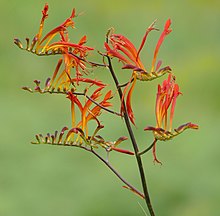| Crocosmia paniculata | |
|---|---|

| |
| Scientific classification | |
| Kingdom: | Plantae |
| Clade: | Tracheophytes |
| Clade: | Angiosperms |
| Clade: | Monocots |
| Order: | Asparagales |
| Family: | Iridaceae |
| Genus: | Crocosmia |
| Species: | C. paniculata |
| Binomial name | |
| Crocosmia paniculata (Klatt) Goldblatt | |
| Synonyms | |
|
Antholyza paniculata Klatt | |
Crocosmia paniculata is a bulbous flowering plant that is native to eastern South Africa, Lesotho, and Eswatini, growing in wet areas by streams, marshes, and drainages. Plants reach 4 to 5 ft (1.2–1.5 m) tall, with lanceolate leaves and deep orange to orange-brown flowers. It is a popular ornamental plant.
The plant has escaped cultivation and become established in the wild in parts of the United Kingdom.
The common name Aunt Eliza is derived from the former generic name Antholyza.
In Lesotho, where it is native, the plant is used by the indigenous Sotho people as an antidiarrhoeal remedy, administered not only to humans, but also to cattle so afflicted.
References
- "Crocosmia". Pacific Bulb Society. Retrieved 4 September 2012.
- Protected Species and Non-Native Species (PDF), London, UK: Department for Environment, Food and Rural Affairs, 2007, p. 13, archived from the original (PDF) on 2010-12-05, retrieved 2010-03-01
- "Crocosmia paniculata - Aunt Liza". The African Garden. Retrieved 4 September 2012.
- "Medicinal and Poisonous Plants of Southern and Eastern Africa" Watt J.M. and Breyer-Brandwijk M.G. pub. E&S Livingstone 1962 p.504 (under synonym Curtonus paniculatus N.E. Br.)
External links
| Taxon identifiers | |
|---|---|
| Crocosmia paniculata |
|
| Antholyza paniculata | |
This Iridaceae article is a stub. You can help Misplaced Pages by expanding it. |